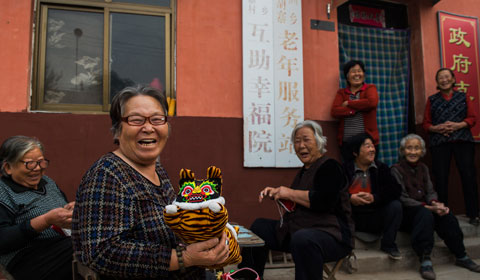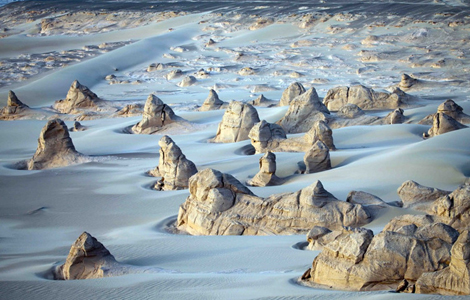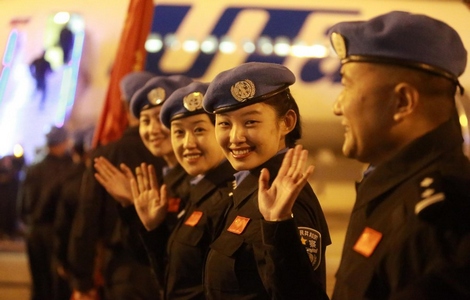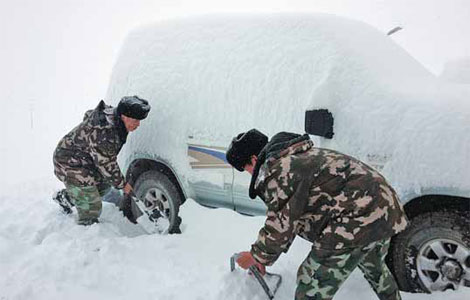Development and progress of Tibet
Updated: 2013-10-23 07:11
(China Daily)
|
||||||||
Editor's note: The Information Office of the State Council, China's Cabinet, on Tuesday published a white paper titled the Development and Progress of Tibet. Following is the full text filed by the Xinhua News Agency.
Foreword
Tibet is located in the southern part of the Qinghai-Tibet Plateau and stands at the southwestern border of China. It is an autonomous region of the People's Republic of China.
Tibet has been an integral part of China since ancient times. Prior to the 1950s, Tibet was a society of feudal serfdom under theocratic rule, a society characterized by a combination of political and religious powers. Government officials, aristocrats and monasteries collectively maintained tight control over Tibet's resources and wealth, and the Tibetan people lived in dire misery without any freedom. At that time, Tibet was as dark and backward as medieval Europe.
The founding of the People's Republic of China in 1949 marked Tibet's entry into modern civilization. After a series of important historical stages, from its peaceful liberation and democratic reform to the establishment of the autonomous region and the reform and opening-up drive, Tibet has steered itself into a fast lane of development together with the rest of China.
Half a century later, Tibet is a world totally different from its old self before the 1950s. The Tibetan people have gained freedom, equality and dignity, and are fully enjoying the fruits of modern civilization. They are working hard in unison toward the building of a united, democratic, affluent, culturally and ethically advanced and harmonious socialist society in the Tibet Autonomous Region.
The development and progress in Tibet is in accord with the rules for the development of human society, and reflects the mutual aspirations of the people of all ethnic groups in Tibet. It is the natural result of the overall development and progress of China as a whole. The development and progress of Tibet mirrors the victory of human society's enterprising spirit and creativity in the quest for justice and happiness, and has proved the inevitability of history.
I.
The Development and Progress in Tibet Is the Inevitable Result of History
The development and progress in modern Tibet results from the innate logic of its social and historical environment, and has its roots in China's progress in a larger context. Its development is in line with the advance of world's modern civilization. Prior to 1959, Tibet was a typical society of feudal serfdom under a theocracy, characterized by a combination of political and religious powers. The development and progress in Tibet began right from the ruins of feudal serfdom.
Tibetan society prior to 1959
There is plenty of literature describing the situation of Tibetan society before 1959. From the following excerpts one can have a glimpse at the darkness and backwardness of old Tibet.
In his 1905 book The Unveiling of Lhasa, former British journalist in India Edmund Candler, who worked for the Daily Mail, recorded the details of the old Tibetan society:
Old Tibet "is governed on the feudal system. The monks are the overlords, the peasantry their serfs." "... at present, the people are medieval, not only in their system of government and their religion, their inquisition, their witchcraft, their incarnations, their ordeals by fire and boiling oil, but in every aspect of their daily life." "... he toils a lifetime to win by his own labour and in scanty measure the necessaries ..." Lhasa was "squalid and filthy beyond description, undrained and unpaved. Not a single house looked clean or cared for. The streets after rain are nothing but pools of stagnant water frequented by pigs and dogs searching for refuse."
In Portrait of A Dalai Lama: The Life and Times of the Great Thirteenth, a 1940s work by Charles Bell, the British Tibetologist made observations of the harsh punishments in Tibet: "At the same time the Tibetan criminal code is drastic. In addition to fines and imprisonment, floggings are frequent, not only of people after they have been convicted of an offence, but also of accused persons, and indeed witnesses, during the course of the trial. For serious offences, use is made of the pillory as well as of the cangue, which latter is a heavy square wooden board round the neck. Iron fetters are fastened on the legs of murderers and inveterate burglars. For every serious or repeated offences, such as murder, violent robbery, repeated thefts, or serious forgery, the hand may be cut off at the wrist, the nose sliced off, or even the eyes gouged out, the last more likely for some heinous political crime. In former days those convicted of murder were put into a leather sack, which was sewn up and thrown into a river."
The Canadian Tibetologist A. Tom Grunfeld published The Making of Modern Tibet in 1987. In it he wrote: "Tibetans were ruled by an unusual form of feudal theocracy.... The heads of the feudal estates maintained a monopoly of power over all local matters. Serfs were 'tied' to their masters.... So powerless were they that they required permission to enter a monastery and even to marry. If two serfs of different lords married, the male offspring reverted to the father's lord, while the female offspring went to the mother's. Permission to leave the estate -- even for the briefest period -- for such matters as family visits, pilgrimages or for some sideline trading required the consent of the lord. Historically there was very little class mobility in Tibet, and for the most part serfs were forced to accept the position they found themselves in upon birth. There is no evidence to support the images of a utopian Shangri-la."
Two Chinese officials, Shen Zonglian and Liu Shengqi, who worked at the Chinese government's Mongolian and Tibetan Affairs Commission's Tibet office before 1949, wrote in their 1953 book Tibet and Tibetans: "The men who have been running the Lhasa government are drawn from the top class of fewer than a hundred still flourishing noble families and an ecclesiastical hierarchy of equal size. To them the Tibetan masses are the 'hewers of wood and drawers of water.'Cut off completely from world trends and from all the dormant social forces in Tibet, and basking in the waning sunshine of a theocratic-feudalistic autocracy, this privileged class can exist only on the ignorance and political lethargy of the Tibetans. Their privileged status is bound to collapse in this fast-changing world, and the process is only going to be accelerated."
For centuries Tibetan society was mired in stagnation due to its backward serfdom and the isolated geographic location of Tibet. By the middle of the 20th century, when humanity was leaping toward modern civilization, Tibet still lagged far behind the rest of the world.
Milestones of Tibet's development and progress
The founding of the People's Republic of China in 1949 opened up new prospects for the nation's development and progress on an unprecedented level. In 1951, the Central People's Government and the local Tibetan government signed the Agreement on Measures for the Peaceful Liberation of Tibet, signifying the beginning of Tibet's development and progress together with the people of the whole nation.
The year 1959 marked a turning point in Tibet's history. In that year the reactionary upper ruling strata of Tibet failed in an armed rebellion to perpetuate feudal serfdom, and the Central Government publicly announced the dismissal of the Tibetan local government. Meanwhile the people of all ethnic groups in Tibet launched a sweeping democratic reform to overthrow Tibet's feudal serfdom system under theocracy that had been in place for hundreds of years, ushering in a social reform that was considered the most extensive, profound and progressive in Tibetan history. The democratic reform liberated about a million serfs and slaves, and brought the basic human rights of equity and freedom to the Tibetan people for the first time in history. It laid the necessary economic, political and social foundation for the region's future development and progress.
In 1965, the Tibet Autonomous Region was founded, and the systems of the people's congress and regional ethnic autonomy were established. These events marked the leap forward for Tibetan society from a feudal serfdom under theocracy to socialism, with the people becoming their own masters. With the establishment of the new political system and the dissemination of ideas on democratic politics, the former serfs and slaves as well as the feudal aristocrats all became modern citizens who enjoy equal rights and exercise their political rights to equally participate in the management of state affairs and the affairs of their local ethnic groups autonomously. In this way, the Tibetan people were greatly motivated to use their enthusiasm and creativity to build a better future.
At the end of 1978, Tibet initiated the reform and opening-up drive toward modernization along with the rest of the country, ushering in a new stage of economic and social development. The Central Government set lofty goals for Tibet, striving to quicken its development and advancing it to the front row of the "four modernizations." In light of the local conditions, the government decided on guiding principles for the work in Tibet in the new era and issued favorable policies for Tibet's development. These moves vigorously contributed to the development and progress in Tibet.
In the 21st century, Tibet has entered the fast lane of development. At the Fifth Symposium on Work in Tibet held in January 2010, the Central Authorities set the goals for Tibet's development in the next stage. The objectives for 2015 are to maintain the pace of leapfrog economic development, significantly narrow the gap between the per capita net income of farmers and herdsmen in Tibet and the national average, significantly increase Tibet's ability to provide public services, further improve the ecosystem, greatly develop Tibet's infrastructure, achieve unity and harmony among all ethnic groups, maintain social stability, and make a more solid foundation for building a moderately prosperous society in all respects.
The objectives set for 2020 are to raise the per capita net income of farmers and herdsmen in Tibet so that it will be close to the national average, comprehensively raise the living standards of the people, improve its basic public services to approach the national average level, comprehensively improve infrastructure conditions, achieve significant results in creating an ecological security screen, greatly increase Tibet's capabilities for self-development, make Tibetan society more harmonious and stable, and ensure that a moderately prosperous society in all respects is established. With these goals achieved, better prospects for development will emerge in Tibet.
Development and progress in Tibet is the victory of human justice
The development and progress of Tibet is in accordance with the rules for the development of human society. From traditional agriculture and animal husbandry to a modern market economy, from the integration of political and religious powers to their separation, from autocracy to democracy, superstition to science, and isolation to openness - these are the generic laws for the development of human society. Over the past 60 years of its development, Tibet has unfailingly followed these rules and the general trend. Today, despite the existing gaps in the level of development between Tibet and other provinces, autonomous regions and municipalities in China, Tibet has narrowed the distance and basically realized synchronized growth with the rest of the country. Observed from the macro perspective of human history, Tibet has leapt from a feudal serfdom society into one with a modern civilization within a matter of only a few decades, creating an outstanding example of regional modernization.
The development and progress of Tibet is inevitably connected with the overall development and progress of China. The fate of Tibet has always been closely linked to the fate of China. Since the advent of modern times, Chinese society has been challenged by the daunting task of comprehensive transition to modernization. Tibet, as an inalienable part of China, also follows the general logic of social reform in the country. During the process of peaceful liberation of Tibet, Mao Zedong, leader of the Communist Party of China, set the course for transforming old Tibet into a "people's democratic Tibet." The profound and unprecedented changes in Tibet over the past 60 years have been consequently realized through the establishment and progress of the political, economic, social and cultural systems of the nation as a whole.
The development and progress of Tibet serves the fundamental interests of the people of all ethnic groups in Tibet. The development and progress of Tibet is the cause of the Tibetan people. In the past six decades, the development and progress of Tibet has always centered around the people's fundamental interests. In Tibet the self-improvement of individuals is consistent with the progress of society, with which more social wealth is created and thus meets the ever-growing material and cultural needs of the people. Essentially, the development and progress of Tibet reflects man's development and the realization of the people's principal position. It is a great practice for respecting and guaranteeing human rights. The development of Tibet has been a process in which people are gaining more and more freedom on the road to liberation, as well as the transformation from "deity first" to "people first." It marks the victory of the Tibetan people over the shackles of theocracy, and honors their pursuit of dignity and personal value. It is the Tibetan people who have benefited most from Tibet's development and progress.
 Apple unveils new Macs, iPad ahead of holidays
Apple unveils new Macs, iPad ahead of holidays
 Smart cities to aid urbanization
Smart cities to aid urbanization
 In control & breaking the mold
In control & breaking the mold
 Higher retirement age may help solve pension problem
Higher retirement age may help solve pension problem
 Northeast remains shrouded in smog for third straight day
Northeast remains shrouded in smog for third straight day
 Beijing Opera troupe perform in Brazil
Beijing Opera troupe perform in Brazil
 Nature's masterpieces
Nature's masterpieces
 Riot police off to Libya peacekeeping mission
Riot police off to Libya peacekeeping mission
Most Viewed
Editor's Picks

|

|

|

|

|

|
Today's Top News
NASA: Chinese scientists are now welcome
Yingli uses US baseball stars in campaign
Top officials promote new relations
China's US Treasury holdings hit six-month low
Graduate looks at kung fu-hip hop connection
Apple unveils new Macs, iPad
San Francisco train service restarts after strike
China, Russia reach big oil deal
US Weekly

|

|






